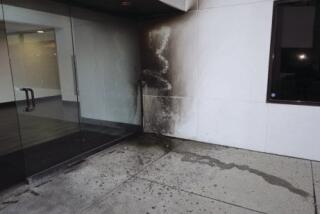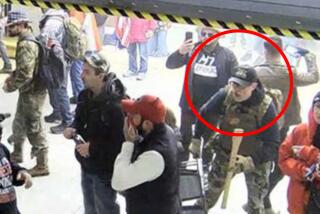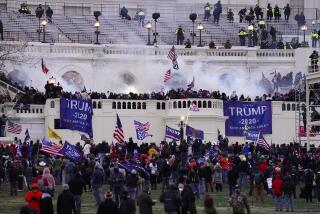Viper Militia Member Wins Acquittal on Explosives Charge
- Share via
PHOENIX — A federal jury acquitted Viper Militia member Christopher Floyd on Tuesday of an explosives-possession charge and said it was hopelessly deadlocked on a related conspiracy charge.
U.S. District Judge Earl Carroll declared a mistrial on the conspiracy count.
Floyd, 22, was one of 12 Viper members arrested in July 1996. Federal investigators said at the time of the arrests that they had headed off a major terrorist act against federal buildings in Phoenix, but the Vipers were charged only with weapons and explosives violations.
Ten members of the group pleaded guilty and were sentenced to prison. Another member, Charles Knight, was convicted by a jury and sentenced in September to nearly six years in prison.
Floyd was accused of possession of a destructive device and conspiracy to possess a destructive device. He faced up to 15 years in prison if convicted on both counts.
Although the government can retry Floyd on the deadlocked conspiracy count, his attorney, Antonio Zuniga, said it was unlikely that would happen.
“There’s an offer on the table that’s pretty good,” he said. He declined to say which side had made the offer but said it called for Floyd to serve a year’s probation, with charges dropped after that if he completed it successfully.
Assistant U.S. Atty. Frederick Battista declined to comment on any deal. He said the government will decide whether to retry Floyd by next week.
Floyd told a reporter last week that he thought the government “blew it” in making its case against him on the possession count because its witnesses weren’t strong enough. He declined to comment further on Tuesday.
At the center of the possession count was the government’s claim that Floyd constructed a bomb from a soft drink can and detonated it during a Viper training exercise in the desert.
Floyd acknowledged in testimony that he shot an illegal machine gun and ignited a bag of plastic C-4 explosives during the exercise, which the government said was designed to train the group for combat with enemies of the group, like the United Nations and police. But he denied making or using an aluminum can bomb.
Government experts from the federal Bureau of Alcohol, Tobacco and Firearms testified that there was not enough evidence to prove that shards of a can that were presented as evidence came from an explosion.
More to Read
Sign up for Essential California
The most important California stories and recommendations in your inbox every morning.
You may occasionally receive promotional content from the Los Angeles Times.










